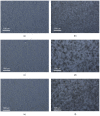Initial Biological Assessment of Upconversion Nanohybrids
- PMID: 34680536
- PMCID: PMC8533627
- DOI: 10.3390/biomedicines9101419
Initial Biological Assessment of Upconversion Nanohybrids
Abstract
Nanoparticles for medical use should be non-cytotoxic and free of bacterial contamination. Upconversion nanoparticles (UCNPs) coated with cucurbit[7]uril (CB[7]) made by combining UCNPs free of oleic acid, here termed bare UCNPs (UCn), and CB[7], i.e., UC@CB[7] nanohybrids, could be used as photoactive inorganic-organic hybrid scaffolds for biological applications. UCNPs, in general, are not considered to be highly toxic materials, but the release of fluorides and lanthanides upon their dissolution may cause cytotoxicity. To identify potential adverse effects of the nanoparticles, dehydrogenase activity of endothelial cells, exposed to various concentrations of the UCNPs, was determined. Data were verified by measuring lactate dehydrogenase release as the indicator of loss of plasma membrane integrity, which indicates necrotic cell death. This assay, in combination with calcein AM/Ethidium homodimer-1 staining, identified induction of apoptosis as main mode of cell death for both particles. The data showed that the UCNPs are not cytotoxic to endothelial cells, and the samples did not contain endotoxin contamination. Higher cytotoxicity, however, was seen in HeLa and RAW 264.7 cells. This may be explained by differences in lysosome content and particle uptake rate. Internalization of UCn and UC@CB[7] nanohybrids by cells was demonstrated by NIR laser scanning microscopy.
Keywords: cucurbituril; cytotoxicity; upconversion nanoparticles.
Conflict of interest statement
The authors declare no conflict of interest.
Figures






References
-
- Francés-Soriano L., González-Béjar M., Pérez-Prieto J. Synergistic Effects in organic-coated upconversion nanoparticles. In: Altavilla C., editor. Upconverting Nanomaterials: Perspectives, Synthesis, and Applications. CRC Press; Boca Raton, FL, USA: 2016. pp. 101–138.
-
- Li Z., Li X., Yang Y.-W. Photoactive nanoparticles capped with macrocycles as platforms and hosts. In: Pérez-Prieto J., González-Béjar M., editors. Micro and Nano Technologies. Elsevier; Amsterdam, The Netherlands: 2019. pp. 139–167.
Grants and funding
- PID2020-115710GB-I00/Ministerio de Economía, Industria y Competitividad, Gobierno de España
- CEX2019-000919-M/Ministerio de Economía, Industria y Competitividad, Gobierno de España
- PROMETEO/2018/138/Generalitat Valenciana
- IDIFEDER/2018/064/Generalitat Valenciana
- Subprograma Atracció de Talent Contractes Postdoctorals/Universitat de València
LinkOut - more resources
Full Text Sources
Miscellaneous

